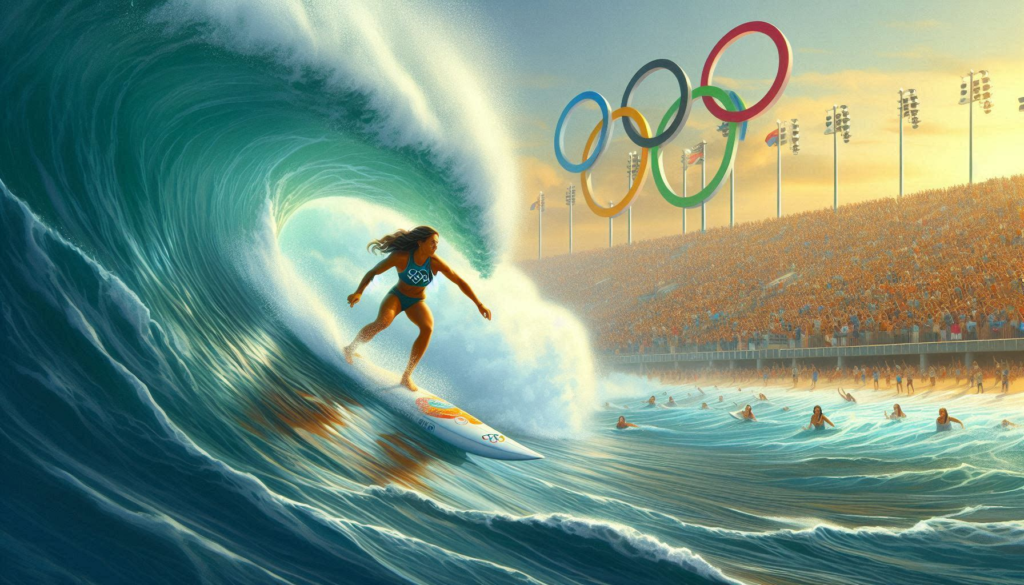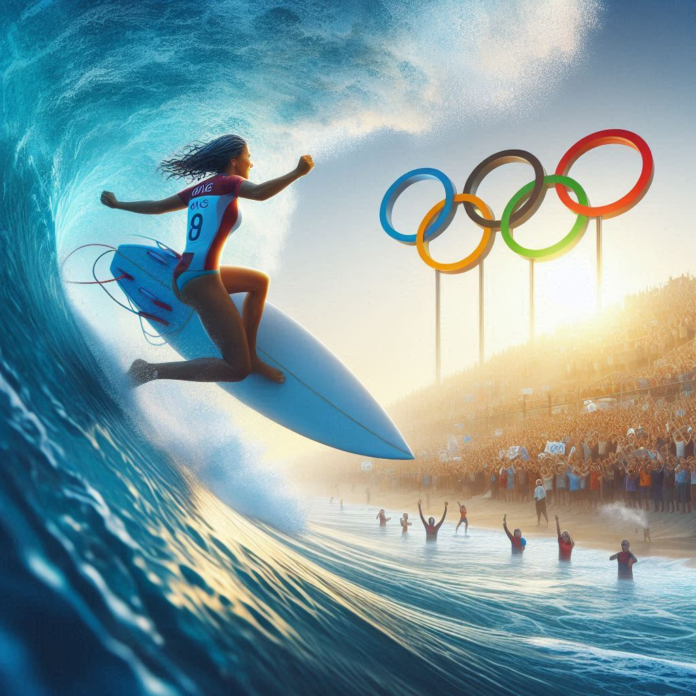Surfing at the Olympics: A Comprehensive Overview
Olympics : Surfing made its historic debut at the Tokyo 2020 Summer Olympics, marking a significant milestone for the sport and its global community. The inclusion of surfing in the Olympics was a long-awaited achievement, bringing the vibrant and free-spirited culture of the sport to the world’s most prestigious sporting stage. This essay delves into the journey of surfing to the Olympics, the format of the competition, key athletes, and the broader impact on the sport and its culture.
The Road to Olympic Inclusion
Historical Background of Surfing
Surfing is an ancient sport with roots tracing back over a thousand years to the Polynesian islands, particularly Hawaii, where it was a central part of the culture. Originally referred to as “heʻe nalu”, surfing was more than play but spirituality, communication with the gods and more individually, triumph over the water space.

In the 20th century, surfing gained international popularity, particularly in the United States and Australia, with the beaches of California and the Gold Coast becoming iconic surfing destinations. The growth of competitive surfing in the 1960s and 1970s, along with the establishment of professional surfing leagues, laid the groundwork for surfing to be considered for the Olympics.
Campaign for Olympic Inclusion
The campaign to include surfing in the Olympics was a long and concerted effort, spearheaded by the International Surfing Association (ISA). The ISA, founded in 1964, worked tirelessly to promote surfing as a global sport and to showcase its appeal and athleticism.
Key milestones in this journey included surfing’s inclusion in the Pan American Games and the Asian Beach Games, which provided a platform to demonstrate the sport’s competitive nature and its appeal to a broad audience. The push for inclusion in the Olympics gained momentum with the appointment of Fernando Aguerre as president of the ISA in 1994. Aguerre’s vision and relentless lobbying were instrumental in surfing being recognized by the International Olympic Committee (IOC).
Finally, in 2016, the IOC announced that surfing would be one of the new sports added to the Tokyo 2020 Olympics, along with skateboarding, sport climbing, and karate. This decision was part of the IOC’s strategy to modernize the Olympic Games and attract a younger audience by incorporating sports that resonate with contemporary youth culture.
Surfing at the Tokyo 2020 Olympics
Venue and Conditions
The surfing competition at the Tokyo 2020 Olympics took place at Tsurigasaki Beach, also known as Shidashita Beach, located about 100 kilometers east of Tokyo in Chiba Prefecture. This location was chosen for its reliable wave conditions and its status as a popular surfing destination in Japan.
The competition was held in the ocean, in keeping with the sport’s natural roots, rather than in an artificial wave pool. The choice of an ocean venue was significant because it introduced an element of unpredictability, as competitors had to adapt to the changing conditions of the sea, including wave height, direction, and wind.
Competition Format
The surfing competition at the Olympics followed a format similar to that used in professional surfing contests. The event featured both men’s and women’s divisions, with 20 competitors in each. There is a representation that is drawn from the ISA World Surfing Games, the World Surf League Championship Tour as well as the other regional qualifiers.
The competition was divided into several rounds:
Heats: The initial rounds consisted of four- or five-person heats, where surfers competed against each other to score the highest points. Each surfer was allowed to catch a maximum of 25 waves, but only their two highest-scoring waves were counted towards their total score.
Scoring: The less the scores awarded to the surfers ranged from a 0. The are awarded in each wave on a scale 1 to 10 depending on the difficulty of the executed movements, the height and power of the wave, style, and the mellowness of the wave. Judges looked for a combination of speed, power, and flow, as well as the ability to execute critical maneuvers in the most critical sections of the wave.
Elimination Rounds: The top two surfers from each heat advanced to the next round, while the others were eliminated from the competition. This process continued until the final round, where the remaining surfers competed for the medals.
Finals: The finals consisted of head-to-head matchups, culminating in a gold medal match between the top two competitors.
Notable Athletes and Performances
The surfing competition at the Tokyo 2020 Olympics featured some of the world’s best surfers, many of whom had already made a name for themselves on the World Surf League Championship Tour.
Men’s Competition: In the men’s competition, Brazilian surfer Italo Ferreira took home the gold medal, making history as the first-ever Olympic champion in surfing. Ferreira, known for his explosive style and powerful aerial maneuvers, dominated the competition despite challenging conditions. Japan’s own Kanoa Igarashi won the silver medal, while Australian surfer Owen Wright secured the bronze.
Women’s Competition: In the women’s competition, Carissa Moore of the United States emerged as the gold medalist. Irish surfer chided as being ‘Moore better’ after a 4 time world champion displayed the best of her abilities, especially on the challenging Tsurigasaki Beach currents. South Africa’s Bianca Buitendag won the silver medal, while Japan’s Amuro Tsuzuki delighted the home crowd by securing the bronze medal.
Cultural and Social Impact
Globalization of Surfing
Due to this addition of surfing in the Olympics around the world has been affected by change. While surfing has traditionally been dominated by countries like the United States, Australia, and Brazil, the Olympics provided a platform for surfers from non-traditional surfing nations to showcase their talent on the world stage.
This exposure has helped to promote the sport in new regions, inspiring a new generation of surfers from around the world. Countries like Japan, South Africa, and Peru, which have strong surfing cultures but have historically been underrepresented in the sport’s upper echelons, gained significant recognition and support through their athletes’ Olympic performances.
Surfing and Youth Culture
Surfing’s inclusion in the Olympics is part of a broader trend by the IOC to make the Games more relevant to younger audiences. Surfing, with its association with youth culture, freedom, and a laid-back lifestyle, is a natural fit for this strategy.
The sport’s image, characterized by its connection to the ocean, environmentalism, and an adventurous spirit, resonates deeply with young people around the world. By featuring surfing in the Olympics, the IOC aimed to connect with this demographic, promoting the Games as a platform for sports that reflect contemporary values and interests.
Impact on Surfing Communities
For the global surfing community, the Olympics represented a validation of their sport. For those who practice surfing, it has always transcended the realm of activity and became a way of living and a tradition. The Olympic inclusion brought surfing into the mainstream, giving it the recognition it deserves as a competitive, athletic endeavor.
However, this mainstream acceptance also brought challenges. Some in the surfing community were concerned that the Olympic spotlight might dilute the sport’s unique culture and values. The commercialization and professionalization of surfing, accelerated by its Olympic status, could potentially lead to a loss of the sport’s soul – the emphasis on connection with nature and the pure joy of riding waves.
Challenges and Controversies
Environmental Concerns
One of the significant challenges associated with surfing in the Olympics is the environmental impact. Surfing is inherently connected to the natural environment, and there were concerns about the ecological footprint of hosting the event at a natural beach.
Environmental activists and local communities in Chiba raised concerns about the potential for increased pollution, disruption to marine life, and the impact of construction on the beach ecosystem. These issues highlighted the need for sustainable practices in organizing such events, balancing the excitement of global competitions with the responsibility to protect natural environments.
The Role of Artificial Wave Pools
Another debate that emerged in the lead-up to the Olympics was the role of artificial wave pools in competitive surfing. Some argued that using wave pools, which can produce consistent and controlled waves, would level the playing field and eliminate the unpredictability of ocean conditions. Others, however, believed that surfing should remain true to its roots, with the natural ocean providing the stage for competition.
While the Tokyo 2020 Olympics opted for a natural ocean venue, the discussion about artificial wave pools continues, particularly as the sport looks ahead to future Olympics. The balance between preserving the authenticity of surfing and adapting to the demands of a global sporting event remains a topic of debate within the surfing community.
The Future of Surfing in the Olympics
Paris 2024 and Beyond
The success of surfing at the Tokyo 2020 Olympics has paved the way for its inclusion in future Games. Surfing is set to return for the Paris 2024 Olympics, but with a significant twist – the event will be held in Tahiti, a French Polynesian island known for its powerful and iconic wave, Teahupo’o.
Teahupo’o is famous for its heavy, barreling waves, offering a stark contrast to the more manageable conditions at Tsurigasaki Beach. The decision to host the event in Tahiti reflects a commitment to showcasing surfing in its most authentic and challenging form, while also highlighting the sport’s cultural and geographical diversity.
Beyond Paris 2024, the future of surfing in the Olympics looks promising, with discussions already underway for its inclusion in the Los Angeles 2028 Games. This is due to the fact that California is one of the premier surfing destinations in the world which means that should surfing be on the Olympic program by 2028, it could gain permanency on the Olympic program.
Evolving the Competition Format
As surfing continues to evolve within the Olympic framework, there may be changes to the competition format to better suit the unique nature of the sport. These could include adjustments to the scoring system, the introduction of different surfing disciplines such as big wave surfing or longboarding, and the potential use of artificial wave pools to ensure consistency in competition conditions.
The continued collaboration between the ISA and the IOC will be crucial in navigating these changes, ensuring that surfing remains true to its roots while adapting to the demands of the Olympic stage.
Conclusion
The inclusion of surfing in the Tokyo 2020 Olympics was a landmark moment for the sport, providing a global platform for surfers to showcase their skills and bringing the culture of surfing to a broader audience. This achievement was the result of decades of effort by the surfing community and its governing bodies, and it has had a profound impact on the sport’s visibility and growth.
Surfing’s Olympic debut highlighted the sport’s unique blend of athleticism, artistry, and connection to nature, while also presenting challenges related to environmental sustainability and the preservation of surfing culture. As surfing looks ahead to future Olympic Games, it will continue to evolve, embracing new opportunities and navigating the complexities of being part of the world’s largest sporting event.
The journey of surfing to the Olympics is a story of perseverance, passion, and the unyielding spirit of a community that has always ridden the waves of change with grace and determination. As the sport continues to grow and adapt, the Olympic Games will undoubtedly play a significant role in shaping its future, ensuring that surfing remains a vibrant and integral part of the global sporting landscape.



